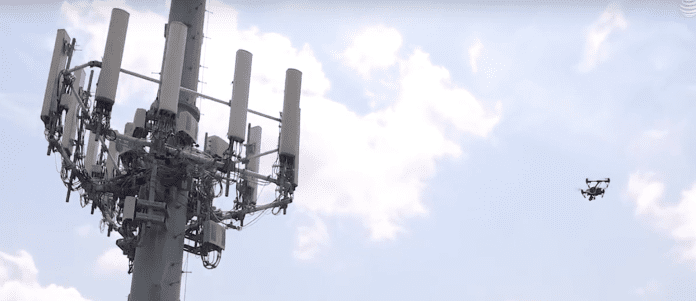AT&T is already using unmanned aerial vehicles to survey and inspect cell towers, and now the carrier is investing in software to help drones autonomously repair tower equipment and carry radios to places where network traffic is heavy. Right now, the U.S. Federal Aviation Administration does not allow drones to fly without a human pilot on the ground, but those rules are expected to change as drone technology advances.
“One day in the future the network will be monitoring customer demand over large geographies throughout the day and then the network would autonomously dispatch radio-equipped drones to temporarily add capacity where needed,” explained Art Pregler, director of national mobility systems at AT&T. “So the network could send the drones out and then send the drones back to their stations or to other locations as the customer demand fluctuates throughout the day.”
Right now, AT&T’s experimental flying cell sites are tethered to the ground. The carrier calls these flying COWS because they are based on some of the same technology that enables AT&T’s cell sites on wheels.
In addition to dynamically adding capacity to the wireless network, drones will have the ability to repair network equipment, Pregler said. Drones are already photographing cell sites, and the next step is to teach them to interpret those pictures. Pregler’s group is partnering with AT&T Labs to develop the software that will enable this.
“There are some great minds there making great headway in terms of training an algorithm to identify equipment on our towers and then going to the next step and having the drones determine what constitutes good quality and bad quality and what actions to take beyond that,” Pregler explained. Drones outfitted with robotic arms could someday remove or repair faulty equipment.
So far, tower inspections have been AT&T’s primary job for drones. Pregler said the company invested in drone technology because sending drones to the tower tops is safer than sending climbers. The company works with roughly half a dozen drone service providers, and also allows its contractors to use drones once AT&T has ensured that they are properly trained and credentialed.
The next job for drones is likely to be network testing. Pregler said his group is working on this because AT&T’s radio frequency engineers are interested in using drones.
“Drones can map RF antenna patterns and do the RF drive test and look for signal interference,” he said. “There is interest there and we have been doing some test cases around the country to show that.”
Network testing is likely to be AT&T’s next use case for drones, while tower maintenance and network capacity management are a little further away. The company will be keeping a close eye on drone developments in Washington, D.C. Even if the FAA continues to require ground-based pilots for the foreseeable future, the agency could lift the rule that requires those pilots to keep their drones within eyesight. That would allow drones to travel further and could decrease the personnel cost associated with their use.

